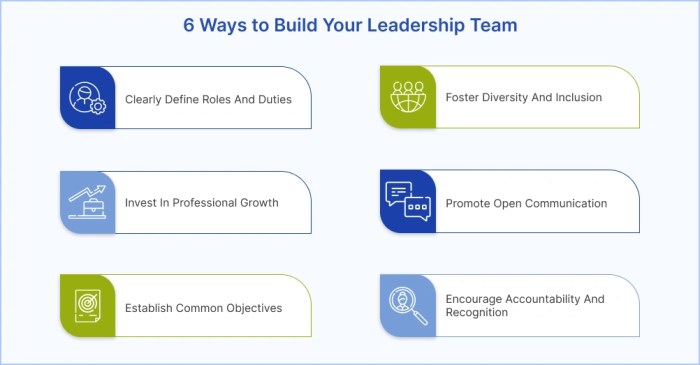Four leadership tips bring out the best your team. Unlocking peak performance in your team requires more than just assigning tasks. It demands understanding team dynamics, fostering effective communication, empowering individuals, and motivating the whole group. This exploration delves into practical strategies for leaders to cultivate a high-performing and engaged team, focusing on fostering trust, adaptability, and continuous improvement.
We’ll examine how understanding your team’s unique dynamics, from collaborative to competitive, is key to addressing potential conflicts and creating a positive environment. Strong communication skills, including active listening and constructive feedback, are essential. We’ll also explore the power of delegation and empowerment, showing how to trust your team to own their work without micromanaging. Finally, discover how to motivate your team through recognition, building trust, and promoting adaptability to navigate challenges.
Understanding Team Dynamics
A successful team isn’t just a collection of individuals; it’s a complex system where interpersonal relationships, communication styles, and shared goals intertwine to create either a powerhouse or a stumbling block. Understanding and nurturing these dynamics is crucial for unlocking optimal performance and fostering a positive work environment. Effective team leadership recognizes and leverages the unique strengths of each member, fostering a climate of collaboration and shared success.Team dynamics encompass the patterns of interaction, communication, and collaboration that emerge within a group.
These patterns can range from highly collaborative efforts to more competitive or individualistic approaches. Recognizing and understanding these different styles is the first step towards building a strong and productive team.
Importance of Team Dynamics
Team dynamics significantly influence a team’s overall effectiveness. A positive and supportive dynamic fosters creativity, improves communication, and boosts morale, leading to higher productivity and better results. Conversely, negative dynamics can lead to conflict, decreased motivation, and ultimately, diminished output. Effective leaders actively cultivate a positive team environment by addressing potential issues proactively.
Types of Team Dynamics
Teams exhibit diverse dynamics, each with its own set of strengths and challenges. Understanding these differences allows leaders to tailor their approach and foster a more productive environment.
- Collaborative Teams: These teams prioritize shared goals and collective effort. Members actively contribute ideas, support each other, and value the input of all team members. This dynamic thrives on mutual respect and a willingness to compromise. An example of a collaborative team could be a software development team working on a project where each member plays a specific role, but all are involved in the overall success of the project.
- Competitive Teams: In these teams, members often compete for recognition and rewards. While healthy competition can spur innovation, it can also lead to conflict if not managed effectively. A competitive environment needs clear goals and a fair evaluation process to maintain a productive atmosphere. An example would be a sales team where individual performance is tracked and rewarded. This team will have different challenges compared to a collaborative team.
- Individualistic Teams: Individualistic teams often focus on individual achievements rather than collective ones. While individual contributions are essential, a lack of collaboration can hinder overall team performance. To address this, leaders need to emphasize the importance of shared goals and mutual support.
Identifying and Addressing Conflicts
Conflicts are inevitable in any team setting. They arise from differing opinions, competing priorities, or personality clashes. Proactive identification and effective management are crucial for maintaining a positive and productive environment.
- Open Communication: Create a safe space for team members to express their concerns and perspectives without fear of judgment. Encourage active listening and empathy. Open communication allows for issues to be resolved constructively.
- Mediation: If conflicts escalate, a neutral third party can facilitate a constructive dialogue between conflicting parties. This ensures both sides feel heard and understood, which is crucial for finding a mutually acceptable solution.
- Conflict Resolution Strategies: Leaders need to be equipped with various conflict resolution strategies, such as compromising, collaborating, or accommodating, depending on the specific situation. This approach allows for effective resolution of disagreements.
Fostering a Positive Team Environment
A positive team environment is characterized by trust, respect, and shared responsibility. Leaders play a crucial role in cultivating this environment.
- Clear Communication: Clear communication is vital for ensuring everyone is on the same page. Regular meetings, clear expectations, and concise documentation contribute to a shared understanding.
- Recognition and Appreciation: Acknowledging and appreciating individual and team accomplishments fosters a sense of value and motivation.
- Team Building Activities: Activities designed to foster collaboration and build relationships can significantly improve team dynamics.
Comparing Communication Styles
Effective communication is fundamental to successful teamwork. Different communication styles can influence team dynamics.
| Communication Style | Description | Strengths | Weaknesses |
|---|---|---|---|
| Direct | Clear, concise, and to the point. | Efficient, easy to understand. | Can be perceived as blunt or insensitive. |
| Indirect | Tends to be more nuanced and considers others’ feelings. | Builds rapport, avoids conflict. | Can be unclear or confusing, potentially delaying action. |
| Active Listening | Focusing on understanding the speaker’s message, both verbally and nonverbally. | Fosters trust, improves understanding. | Can be time-consuming if not managed properly. |
| Passive | Avoiding confrontation, letting others take the lead. | Can de-escalate conflict in some cases. | Can lead to resentment, unresolved issues, and stagnation. |
Enhancing Communication Skills
Effective communication is the cornerstone of successful leadership. A leader’s ability to convey ideas clearly, listen attentively, and provide constructive feedback directly impacts team morale, productivity, and overall success. Strong communication fosters trust, encourages collaboration, and resolves conflicts efficiently. This section will delve into practical techniques to enhance communication skills, enabling leaders to unlock the full potential of their teams.Developing strong communication skills is an ongoing process requiring dedication and practice.
It involves understanding different communication styles, actively listening to diverse perspectives, and providing feedback that is both constructive and actionable. By mastering these techniques, leaders can cultivate a positive and productive work environment where every team member feels valued and empowered.
Effective Communication Techniques for Leaders
Leaders must employ a range of communication techniques to effectively connect with their teams. These techniques include active listening, clear articulation, and providing constructive feedback. These methods, when skillfully applied, can enhance understanding and promote a positive work environment.
Want to unlock your team’s full potential? Four key leadership tips can make a real difference. Building trust, clear communication, and empowering your team members are crucial. But, beyond these practical steps, remember the lessons you can learn from 7 things to remember in your 20s if you don’t want to have regrets – these principles are just as important for leading a team as they are for personal growth.
Ultimately, strong leadership is about fostering a positive and productive work environment, which translates into better outcomes for everyone involved.
Active Listening
Active listening is a crucial element of effective communication. It involves more than just hearing words; it encompasses fully concentrating on the speaker, understanding their message, and responding thoughtfully. This includes paying close attention to verbal cues, such as tone and inflection, as well as nonverbal cues, like body language and facial expressions. By actively engaging with the speaker, leaders demonstrate respect and create a safe space for open communication.
Providing Constructive Feedback
Providing constructive feedback is a vital leadership skill. Constructive feedback focuses on specific behaviors and their impact, offering suggestions for improvement without being overly critical or judgmental. It’s about helping individuals grow and develop, rather than simply pointing out mistakes. A leader should focus on specific examples and behaviors, rather than making general statements. Providing constructive feedback requires a thoughtful and empathetic approach.
Different Approaches to Giving and Receiving Feedback
Different approaches to giving and receiving feedback can significantly impact the effectiveness of the communication process. Leaders should consider the context and the individual’s personality when delivering feedback. For example, some individuals prefer direct feedback, while others might respond better to a more indirect approach. Understanding these nuances allows leaders to tailor their communication style to best support the recipient’s needs.
Giving and receiving feedback should be approached with mutual respect and a focus on improvement.
Comparison of Feedback Approaches
| Approach | Description | Strengths | Weaknesses ||——————-|——————————————————————————————————————————————————————————————————————-|—————————————————————————————————————————————————————————————————————————————————-|—————————————————————————————————————————————————————————————————————————————————-|| Direct Feedback | Straightforward, clear, and specific.
Emphasizes specific behaviors and their consequences. | Can be efficient and provides clarity; allows for immediate action.
| Can be perceived as harsh or confrontational if not delivered with empathy; might not be well-received by all individuals.
|| Indirect Feedback | More subtle and focuses on the impact of the behavior rather than the behavior itself.
It often uses “I” statements to express concerns. | Can be less confrontational; allows for a gentler delivery; might encourage more open discussion.
| Can be less clear or direct, potentially requiring further clarification; may take more time to understand the message.
|| Positive Feedback | Highlights strengths and accomplishments.
Focuses on positive aspects of performance. | Encourages motivation and boosts morale; fosters a positive work environment.
| Can be perceived as superficial if not tied to specific behaviors; might not be sufficient to address specific areas needing improvement.
|| Constructive Feedback | Combines positive and negative feedback, providing specific examples and actionable suggestions for improvement.
| Balances recognition of strengths with identification of areas needing attention; helps employees understand expectations and make improvements.
| Requires careful consideration of both positive and negative elements; may be perceived as complex or overwhelming by some individuals.
|
Communication Channels and Their Appropriateness
Effective communication relies on selecting the appropriate channel for the message. The choice of channel should be guided by factors such as urgency, complexity of the message, and the desired level of formality.
| Communication Channel | Description | Appropriateness |
|---|---|---|
| Face-to-face meetings | Direct interaction; allows for immediate feedback and clarification. | Important announcements, sensitive discussions, team-building activities. |
| Formal communication; suitable for conveying information or instructions. | Sharing updates, scheduling meetings, providing information. | |
| Instant messaging | Quick communication; suitable for informal exchanges and urgent requests. | Quick questions, simple updates, coordinating tasks. |
| Team meetings | Gathering team members to discuss project updates and progress. | Project updates, brainstorming sessions, problem-solving. |
| Written reports | Detailed documentation of information and data. | Presenting data, providing analysis, formal proposals. |
Clear and Concise Communication
Clear and concise communication is essential for conveying information effectively. This involves using precise language, avoiding jargon, and structuring messages logically. Leaders should strive to deliver information in a way that is easy to understand and act upon. Effective communication is more than just sharing information, it’s about ensuring the message is received, understood, and acted upon.
Delegation and Empowerment: Four Leadership Tips Bring Out The Best Your Team
Unlocking the potential of your team often hinges on your ability to delegate effectively and empower your team members. Delegation isn’t just about offloading tasks; it’s about fostering growth, building trust, and creating a more dynamic and engaged team. By assigning responsibilities wisely and supporting your team through the process, you’ll not only improve productivity but also cultivate a sense of ownership and accomplishment within your team.Delegation is a powerful leadership tool that allows you to maximize your team’s resources and potential.
It fosters trust and empowers team members to take initiative, leading to increased job satisfaction and a more engaged workforce. It’s crucial for leaders to understand the art of delegation and how to effectively empower team members to take ownership of their work.
Benefits of Delegation for Team Members and Leaders
Delegation offers numerous benefits for both team members and leaders. For team members, it provides opportunities to develop new skills, gain experience, and increase their confidence. For leaders, delegation frees up time for strategic tasks, allowing them to focus on the bigger picture and fostering a more collaborative and productive work environment. Delegation is a vital part of effective leadership.
Effective leadership hinges on understanding how your brain works, and how to overcome its inherent biases. For example, four key leadership tips to unlock your team’s potential include clear communication, empowering delegation, fostering collaboration, and providing constructive feedback. But sometimes our own mental processes get in the way. Understanding these common pitfalls, as detailed in this insightful article on 7 mistakes your brain makes every day and how fix them , can help you lead more effectively.
By recognizing and mitigating these brain-based issues, you can better implement these four leadership tips and ultimately achieve superior results from your team.
Strategies for Assigning Tasks Effectively
Effective task assignment is key to successful delegation. Clearly defining tasks and expectations is paramount. Leaders should provide specific instructions, including deadlines, resources, and expected outcomes. Communicating clearly and openly is essential for ensuring everyone understands the task and its significance.
- Detailed Instructions: Clearly define the task, outlining specific responsibilities, expected outcomes, and deadlines. Provide all necessary resources and information.
- Clear Communication: Establish clear lines of communication for questions and feedback. Hold regular check-ins to monitor progress and address any concerns.
- Appropriate Skill Matching: Consider each team member’s strengths and weaknesses when assigning tasks. Match the task to the appropriate skill set to ensure successful completion.
- Establishing Expectations: Define clear expectations regarding quality, timeliness, and adherence to established procedures. Providing clear guidelines for acceptable outcomes helps ensure the task is completed to the desired standard.
Empowering Team Members to Take Ownership
Empowering team members is crucial for fostering a sense of ownership and responsibility. Trusting your team members with autonomy and providing the necessary support is essential.
- Trust and Autonomy: Provide team members with the autonomy to make decisions and manage their work within defined parameters. Trusting your team members is essential for fostering a sense of responsibility.
- Providing Resources: Ensure team members have access to the necessary resources, tools, and support to complete their tasks effectively. This includes providing necessary training and support.
- Recognition and Feedback: Acknowledge and appreciate the efforts and contributions of your team members. Provide regular, constructive feedback to help them improve and grow.
Monitoring Progress and Providing Support
Monitoring progress is crucial for ensuring tasks are completed effectively and on time. However, avoid micromanaging. Regular check-ins and constructive feedback are vital for supporting team members without stifling their progress.
- Regular Check-ins: Schedule regular check-ins with team members to discuss progress, address any challenges, and provide support.
- Constructive Feedback: Offer constructive feedback that focuses on specific actions and outcomes, rather than making general criticisms. Emphasize growth and improvement rather than dwelling on errors.
- Avoid Micromanagement: Trust your team members to manage their work. Avoid excessive oversight or interference. Provide guidance when needed, but allow for independent problem-solving.
Delegation Strategies that Promote Growth
Delegation strategies should be designed to promote team member growth and development.
- Mentorship and Coaching: Pair experienced team members with those who are newer or less experienced to provide guidance and support.
- Challenging Assignments: Assign tasks that stretch team members’ capabilities and encourage them to develop new skills. Avoid assigning tasks that are too easy or too difficult.
- Cross-Training: Encourage team members to take on tasks outside their typical responsibilities to broaden their skill sets and gain a deeper understanding of different aspects of the project.
Motivation and Recognition
Unlocking the full potential of your team requires understanding their motivations and providing meaningful recognition for their contributions. A motivated team is a high-performing team, and effective recognition fosters a positive and productive work environment. This is crucial for sustained success and achieving shared goals.Aligning individual motivations with team objectives is key to achieving optimal performance. Recognizing achievements, no matter how small, reinforces positive behaviors and cultivates a culture of appreciation, which in turn fosters loyalty and commitment.
Different Motivational Factors
Understanding the diverse range of motivations within your team is essential for tailored approaches to recognition. Some team members may be intrinsically motivated by the work itself, while others might be driven by external factors such as career advancement or financial rewards. Analyzing individual preferences and values can guide leadership in tailoring recognition strategies to resonate with each member’s unique needs.
This understanding leads to a more effective approach to boosting morale and performance.
Methods for Recognizing Contributions
Recognition methods should be diverse and encompass a range of approaches. This ensures that different individuals are motivated and appreciated in ways that resonate with their personal values. Simple gestures like verbal praise can be incredibly effective, while more formal acknowledgements like awards or public recognition can bolster team spirit and encourage further contributions. Furthermore, timely and specific feedback enhances the impact of any recognition method.
Creating a Culture of Appreciation
Cultivating a culture of appreciation requires consistent effort and commitment from all team members. It’s not just about recognizing achievements; it’s about creating an environment where everyone feels valued and respected. This fosters a positive feedback loop where individuals feel motivated to contribute their best work, knowing that their efforts are acknowledged and appreciated. Leaders should proactively seek opportunities to express gratitude and create opportunities for peer-to-peer recognition.
Positive Reinforcement for Continued Success
Positive reinforcement is a powerful tool for encouraging continued success and high performance. By consistently rewarding desired behaviors and achievements, you create a positive association between effort and outcome. This approach encourages individuals to strive for excellence and motivates them to maintain a high level of performance. This reinforces the value of consistent effort and achievement.
Want to unlock your team’s full potential? Focusing on four key leadership tips is crucial. Effective communication, clear goals, and fostering a supportive environment are essential. To further enhance your skills, exploring 10 management and business skills everyone should learn more productive can provide valuable insights into modern approaches. Ultimately, these insights will help you refine your leadership style and guide your team towards success.
Comparison of Recognition Methods
| Recognition Method | Description | Pros | Cons |
|---|---|---|---|
| Verbal Praise | Directly acknowledging a contribution or positive behavior | Immediate, inexpensive, fosters positive reinforcement | May not be sufficient for all individuals |
| Awards | Formal recognition, tangible rewards | Motivates, publicly acknowledges achievement | Can be expensive, may not resonate with all team members |
| Bonuses | Financial rewards | Tangible incentive, often highly motivating | Requires careful consideration of budget, may not be appropriate in all cases |
| Public Recognition | Highlighting contributions in team meetings, newsletters | Boosts morale, fosters a culture of appreciation | Requires careful planning, may not be appropriate for all achievements |
Adaptability and Resilience

Navigating the ever-changing landscape of the modern workplace requires leaders to be more than just competent; they must be adaptable and resilient. A leader’s ability to adjust strategies, embrace change, and bounce back from setbacks directly impacts team morale and productivity. This adaptability and resilience aren’t just desirable traits; they are essential for success in today’s dynamic environment.Effective leadership in the 21st century demands a proactive approach to change and challenges.
Leaders must not only anticipate potential disruptions but also equip their teams with the tools and strategies to thrive amidst uncertainty. Resilience, the ability to recover from adversity, is equally crucial. Leaders who foster resilience in their teams empower them to overcome obstacles and emerge stronger.
Importance of Adaptability in Leadership
Adaptability is the cornerstone of effective leadership. It allows leaders to adjust their approaches and strategies in response to changing circumstances, market trends, or team needs. This flexibility fosters a culture of continuous improvement and allows teams to remain competitive and innovative. A leader who is rigid in their approach is less likely to successfully guide their team through unforeseen obstacles.
Examples of Situations Where Adaptability is Crucial
Adaptability is critical in numerous situations. Consider a sudden shift in market demand, where a company must quickly adjust its production strategies. A leader who can adapt quickly to this change will better position the team for success. Similarly, unforeseen technological advancements or regulatory changes necessitate a flexible response from leaders to ensure smooth transitions and maintain team productivity.
Strategies for Leading Teams Through Change and Challenges
Leading teams through change and challenges requires a multifaceted approach. Effective communication is paramount; keeping the team informed about the changes and their impact is vital. Transparency builds trust and allows for open discussion, which is crucial during periods of uncertainty. Secondly, providing opportunities for team members to express concerns and contribute ideas helps foster a sense of ownership and engagement.
Empowering teams to develop their own solutions fosters creativity and innovation.
Importance of Resilience in Overcoming Obstacles, Four leadership tips bring out the best your team
Resilience, the ability to bounce back from adversity, is essential for overcoming obstacles. Leaders who exhibit resilience inspire their teams to persevere through difficult times. They demonstrate that setbacks are opportunities for growth and learning. This positive attitude can turn a seemingly insurmountable challenge into an opportunity for innovation and progress.
Methods for Managing Stress and Anxiety
Effective stress management is crucial for both leaders and team members. This is particularly true in periods of significant change or uncertainty. The following table illustrates various methods for managing stress and anxiety, helping individuals cope with the pressures of leadership and maintain well-being.
| Method | Description | Example |
|---|---|---|
| Mindfulness Meditation | Focusing on the present moment without judgment. | Practicing deep breathing exercises and focusing on bodily sensations. |
| Exercise | Physical activity to release endorphins and reduce stress hormones. | Going for a run, taking a walk, or participating in a team sport. |
| Healthy Diet | Nourishing the body with balanced meals. | Eating fruits, vegetables, and lean proteins. |
| Time Management | Prioritizing tasks and setting realistic deadlines. | Creating a to-do list and scheduling time for specific tasks. |
| Social Support | Connecting with friends, family, and colleagues for emotional support. | Talking to a trusted friend or family member about concerns. |
| Professional Help | Seeking guidance from a therapist or counselor. | Consulting a mental health professional for personalized support. |
Building Trust and Rapport
Trust is the bedrock of any successful team. It’s not simply a feeling; it’s a crucial element that fosters open communication, encourages collaboration, and ultimately drives high performance. Without trust, team members are hesitant to share ideas, take risks, or support one another. Building strong rapport goes hand-in-hand with establishing trust, creating a positive and productive atmosphere where individuals feel valued and respected.Establishing trust and rapport within a team requires conscious effort and consistent demonstration of positive behaviors.
This involves actively listening to team members, acknowledging their contributions, and demonstrating genuine respect for their perspectives. Trust is earned, not demanded, and it’s essential to understand that it takes time and consistent effort to cultivate.
The Role of Trust in Team Success
Trust significantly impacts team effectiveness. High levels of trust allow team members to feel safe expressing differing opinions, taking calculated risks, and supporting one another through challenges. This fosters a collaborative environment, enabling teams to solve problems more effectively, innovate more readily, and achieve shared goals. Trust promotes psychological safety, enabling individuals to contribute freely without fear of judgment or retribution.
Methods for Building Trust Among Team Members
Building trust requires consistent effort and demonstrates that you value your team members. Open communication, active listening, and showing empathy are key. Regular team-building activities, opportunities for informal interaction, and a culture of shared values contribute to a stronger sense of belonging. Transparent communication, honest feedback, and keeping commitments consistently are crucial components.
Examples of How Trust Influences Team Performance
Consider a software development team. When trust is high, developers are more likely to share code snippets, ask for help when needed, and provide constructive feedback to each other. This leads to faster problem-solving, higher code quality, and ultimately, a more successful product launch. In contrast, a team lacking trust might experience delays, misunderstandings, and reduced overall performance.
A strong sense of camaraderie also increases productivity.
Strategies for Fostering a Supportive and Collaborative Team Environment
A supportive and collaborative environment is a direct result of trust. Team leaders can encourage this by creating opportunities for informal interaction, celebrating successes together, and fostering a culture of shared values and goals. Encouraging open communication channels and providing regular feedback mechanisms help build understanding and reduce conflicts.
Communication Techniques to Enhance Trust and Rapport
Effective communication is fundamental to building trust. Different techniques can be used to foster understanding and rapport among team members. These methods should be tailored to individual personalities and situations.
| Communication Technique | Description | Example |
|---|---|---|
| Active Listening | Paying close attention to what others are saying, both verbally and nonverbally, and responding thoughtfully. | Asking clarifying questions, summarizing what was heard, and acknowledging the speaker’s feelings. |
| Empathetic Communication | Understanding and sharing the feelings of others. | Putting yourself in another’s shoes, acknowledging their perspective, and showing compassion. |
| Open and Honest Feedback | Providing constructive feedback in a respectful and supportive manner. | Focusing on specific behaviors and their impact, using “I” statements, and offering solutions. |
| Positive Reinforcement | Recognizing and appreciating contributions, both big and small. | Giving verbal praise, acknowledging accomplishments, and expressing gratitude. |
Promoting Continuous Improvement

Constantly striving for betterment is crucial for any team’s sustained success. This involves a proactive approach to identifying areas where processes can be refined and implemented, leading to improved efficiency, higher quality output, and increased job satisfaction. A culture of continuous improvement fosters a dynamic and adaptable team, capable of responding to challenges and capitalizing on opportunities.
Importance of Continuous Improvement in Team Performance
Continuous improvement is not just a desirable trait; it’s a necessity for high-performing teams. By consistently seeking ways to enhance processes, teams can optimize their workflow, minimize errors, and maximize output. This iterative approach to refinement builds a strong foundation for sustained success and adaptability in a rapidly changing environment. Teams that embrace continuous improvement are better equipped to handle challenges and capitalize on emerging opportunities.
Strategies for Identifying Areas for Improvement
Identifying areas for improvement requires a systematic approach. Regular feedback sessions, both formal and informal, are essential for gathering insights from team members. Analyzing performance data, such as project timelines, error rates, and customer satisfaction scores, provides concrete evidence of areas needing attention. Cross-functional reviews and brainstorming sessions, where different perspectives are shared, can reveal previously overlooked issues and potential solutions.
Methods for Implementing Feedback to Enhance Team Processes
Implementing feedback effectively is crucial for translating insights into actionable improvements. A key step is to prioritize feedback based on its potential impact. Clearly defined action plans, outlining specific steps and deadlines, help ensure that feedback is converted into tangible changes. Regular check-ins and progress reports help monitor the implementation of improvements, allowing for adjustments as needed.
This iterative approach ensures that the feedback loop remains active and productive.
Importance of Open Communication Channels for Feedback
Open communication channels are vital for fostering a culture of continuous improvement. Teams should be encouraged to share their thoughts and concerns without fear of retribution. This includes establishing platforms for anonymous feedback, such as suggestion boxes or online surveys. Transparency in communication about progress and challenges fosters trust and encourages collaboration.
Steps for Implementing Changes Based on Feedback
The following table Artikels the steps for implementing changes based on feedback, emphasizing a structured and organized approach:
| Step | Description | Example |
|---|---|---|
| 1. Identify the Issue | Pinpoint the specific area needing improvement, using data and feedback as evidence. | High error rate in data entry. |
| 2. Analyze the Root Cause | Determine the underlying reasons for the issue. | Lack of standardized training, outdated software. |
| 3. Develop a Solution | Create a practical and feasible solution to address the root cause. | Implement new training module, upgrade software. |
| 4. Implement the Solution | Put the solution into action. | Conduct training sessions, install updated software. |
| 5. Monitor Results | Track the effectiveness of the solution and gather feedback. | Monitor error rates after training, solicit feedback from team members. |
| 6. Adjust and Refine | Refine the solution based on the monitoring results. | Modify training materials based on feedback, explore alternative software if necessary. |
Final Conclusion
In conclusion, these four leadership tips provide a roadmap for building a high-performing team. By focusing on understanding team dynamics, enhancing communication, empowering your team, and motivating them through recognition, you can unlock their full potential. Adaptability and resilience are crucial in today’s ever-changing environment. Cultivating a culture of trust and continuous improvement are vital for sustained success.
Ultimately, these tips empower you to lead a team that not only accomplishes goals but also thrives in the process.











